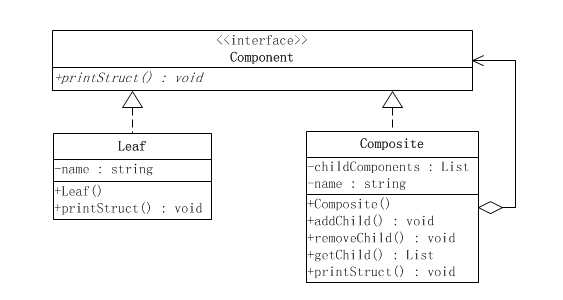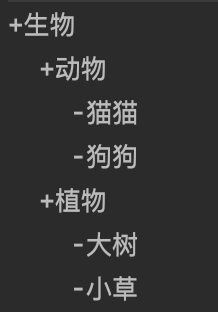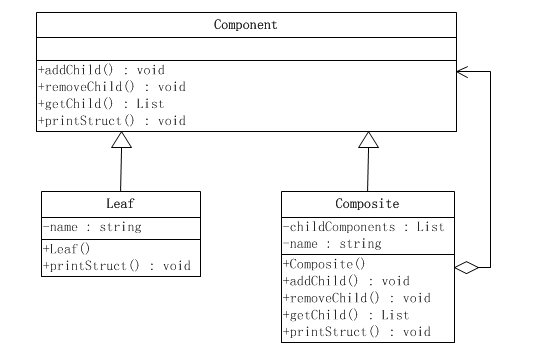- ubuntu12.04环境下使用kvm ioctl接口实现最简单的虚拟机
- Ubuntu 通过无线网络安装Ubuntu Server启动系统后连接无线网络的方法
- 在Ubuntu上搭建网桥的方法
- ubuntu 虚拟机上网方式及相关配置详解
CFSDN坚持开源创造价值,我们致力于搭建一个资源共享平台,让每一个IT人在这里找到属于你的精彩世界.
这篇CFSDN的博客文章java合成模式之神奇的树结构由作者收集整理,如果你对这篇文章有兴趣,记得点赞哟.
以下是互联网的解释.
合成模式属于对象的结构模式,有时又叫做“部分――整体”模式。合成模式将对象组织到树结构中,可以用来描述整体与部分的关系。合成模式可以使客户端将单纯元素与复合元素同等看待.
经常会出现有树结构的情况 , 其中由单独的对象或者单独对象组成的合成对象组成 , 此时就需要利用一种方式来完成树结构的构建工作 . 合成模式提供一个树结构中所有对象的统一接口 , 规范树中单独对象和合成对象的构建过程 , 合成模式更像一个数据结构 . 。
合成模式的实现方式分为透明式和安全式 , 主要区别在于管理方法是在抽象构件中声明, 还是直接在树枝构件中定义. 。
- 透明式 , 管理方法在抽象构件中声明 , 同时树叶节点需要用平庸的方式实现管理方法
- 安全式 , 在树枝构件中直接定义管理方法 , 这样避免在树叶构件中进行定义 .
设计模式和编程语言无关,但是二当家的依然用Java语言去实战举例.
。

。
。
抽象构件声明了叶子和树枝都应该有的行为.
package com.secondgod.composite;/** * 抽象构件 * * @author 二当家的白帽子 https://le-yi.blog.csdn.net/ */public interface Component { /** * 输出自身的名称 */ void printStruct(String preStr);}
。
。
树叶不会再有下级.
package com.secondgod.composite;import java.text.MessageFormat;/** * 树叶 * * @author 二当家的白帽子 https://le-yi.blog.csdn.net/ */public class Leaf implements Component { /** * 叶子对象的名字 */ private String name; public Leaf(String name) { this.name = name; } @Override public void printStruct(String preStr) { System.out.println(MessageFormat.format("{0}-{1}", preStr, name)); }}
。
。
树枝可以继续长出树枝或者树叶,所以要有addChild方法.
package com.secondgod.composite;import java.text.MessageFormat;import java.util.ArrayList;import java.util.List;/** * 树枝 * * @author 二当家的白帽子 https://le-yi.blog.csdn.net/ */public class Composite implements Component { /** * 用来存储组合对象中包含的子组件对象 */ private List<Component> childComponents = new ArrayList<Component>(); /** * 组合对象的名字 */ private String name; public Composite(String name){ this.name = name; } /** * 聚集管理方法,增加一个子构件对象 * @param child 子构件对象 */ public void addChild(Component child){ childComponents.add(child); } @Override public void printStruct(String preStr) { // 先把自己输出 System.out.println(MessageFormat.format("{0}+{1}", preStr, name)); // 如果还包含有子组件,那么就输出这些子组件对象 if (this.childComponents != null) { // 添加两个空格,表示向后缩进两个空格 preStr += " "; // 输出当前对象的子对象 for (Component c : childComponents) { // 递归输出每个子对象 c.printStruct(preStr); } } }}
。
。
package com.secondgod.composite;/** * 测试 * * @author 二当家的白帽子 https://le-yi.blog.csdn.net/ */public class Client { public static void main(String[]args){ Composite root = new Composite("生物"); Composite c1 = new Composite("动物"); Composite c2 = new Composite("植物"); Leaf leaf1 = new Leaf("猫猫"); Leaf leaf2 = new Leaf("狗狗"); Leaf leaf3 = new Leaf("大树"); Leaf leaf4 = new Leaf("小草"); root.addChild(c1); root.addChild(c2); c1.addChild(leaf1); c1.addChild(leaf2); c2.addChild(leaf3); c2.addChild(leaf4); root.printStruct(""); }}

执行结果符合预期.
。

生长树枝和树叶的方法直接声明在抽象构件里。本例使用抽象类,其实也可以使用接口.
package com.secondgod.composite;/** * 抽象构件 * * @author 二当家的白帽子 https://le-yi.blog.csdn.net/ */public abstract class Component { /** * 输出自身的名称 */ public abstract void printStruct(String preStr); /** * 聚集管理方法,增加一个子构件对象 * @param child 子构件对象 */ public void addChild(Component child){ /** * 缺省实现,抛出异常,因为叶子对象没有此功能 * 或者子组件没有实现这个功能 */ throw new UnsupportedOperationException("对象不支持此功能"); }}
透明式的叶子从实现抽象构件改成继承抽象构件。如果抽象构件是接口,则需要平庸实现管理子构件的方法.
package com.secondgod.composite;import java.text.MessageFormat;/** * 树叶 * * @author 二当家的白帽子 https://le-yi.blog.csdn.net/ */public class Leaf extends Component { /** * 叶子对象的名字 */ private String name; public Leaf(String name) { this.name = name; } @Override public void printStruct(String preStr) { System.out.println(MessageFormat.format("{0}-{1}", preStr, name)); }}
透明式的树枝也是从实现抽象构件改为继承抽象构件,这主要跟抽象构件是抽象类还是接口有关.
package com.secondgod.composite;import java.text.MessageFormat;import java.util.ArrayList;import java.util.List;/** * 树枝 * * @author 二当家的白帽子 https://le-yi.blog.csdn.net/ */public class Composite extends Component { /** * 用来存储组合对象中包含的子组件对象 */ private List<Component> childComponents = new ArrayList<Component>(); /** * 组合对象的名字 */ private String name; public Composite(String name){ this.name = name; } /** * 聚集管理方法,增加一个子构件对象 * @param child 子构件对象 */ public void addChild(Component child){ childComponents.add(child); } @Override public void printStruct(String preStr) { // 先把自己输出 System.out.println(MessageFormat.format("{0}+{1}", preStr, name)); // 如果还包含有子组件,那么就输出这些子组件对象 if (this.childComponents != null) { // 添加两个空格,表示向后缩进两个空格 preStr += " "; // 输出当前对象的子对象 for (Component c : childComponents) { // 递归输出每个子对象 c.printStruct(preStr); } } }}
客户端在使用时,变量可以都声明为抽象构件.
package com.secondgod.composite;/** * 测试 * * @author 二当家的白帽子 https://le-yi.blog.csdn.net/ */public class Client { public static void main(String[]args){ Component root = new Composite("生物"); Component c1 = new Composite("动物"); Component c2 = new Composite("植物"); Component leaf1 = new Leaf("猫猫"); Component leaf2 = new Leaf("狗狗"); Component leaf3 = new Leaf("大树"); Component leaf4 = new Leaf("小草"); root.addChild(c1); root.addChild(c2); c1.addChild(leaf1); c1.addChild(leaf2); c2.addChild(leaf3); c2.addChild(leaf4); root.printStruct(""); }}
可以看出,客户端无需再区分操作的是树枝对象(Composite)还是树叶对象(Leaf)了;对于客户端而言,操作的都是Component对象.
。
安全式:从客户端使用合成模式上看是否更安全,如果是安全的,那么就不会有发生误操作的可能,能访问的方法都是被支持的.
透明式:从客户端使用合成模式上,是否需要区分到底是“树枝对象”还是“树叶对象”。如果是透明的,那就不用区分,对于客户而言,都是Compoent对象,具体的类型对于客户端而言是透明的,是无须关心的。因为无论树叶还是树枝,均符合一个固定的接口.
到底使用安全式还是透明式需要看需求,大家看着办吧.
以上就是java合成模式之神奇的树结构的详细内容,更多关于java合成模式的资料请关注我其它相关文章! 。
原文链接:https://blog.csdn.net/leyi520/article/details/119887706 。
最后此篇关于java合成模式之神奇的树结构的文章就讲到这里了,如果你想了解更多关于java合成模式之神奇的树结构的内容请搜索CFSDN的文章或继续浏览相关文章,希望大家以后支持我的博客! 。
tty_driver 结构中的“神奇”值是什么 struct tty_driver { int magic; /* magic number for this stru
这是一个等效的提取代码: #include #include #include #include #include class ChatMessageEdit : public QTextE
我还没有找到适合我的这个问题的具体答案,但也许我误解了一两个关键点。 我正在尝试为一个项目创建数据迁移策略,其中 3 个系统(2 个 MySQL、1 个 MS SQL)将合并到 1 个新系统 (MS
我想在输出 JSON 时从 ActiveRecord/ActiveModel 类中过滤掉特定字段。 最直接的方法就是覆盖 as_json,可能像这样: def as_json (options = n

我是一名优秀的程序员,十分优秀!